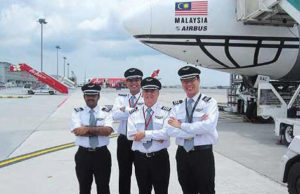
My last London flight, completing 25,500 hours without experiencing an engine failure
If an engine fails on take-off, will the pilot abort the take-off or continue?
When an engine fails on take-off, a pilot’s decision to go or not, would depend on the speed it has attained.
From day one, a pilot is reminded that, for every take off, be prepared for an abort and for every landing, be prepared for a go-around, basically following the boy’s scout motto, ‘Be Prepared!’ and be in a state of readiness in mind and action.
How does a pilot make the ‘go’ or ‘no-go’ decision?
Simple, it’s all about speeds. Every plane has a pre-calculated ‘take off decision speed’ or what a pilot calls a V1 speed.
V1 (e.g. 145 knots) is the maximum speed during take-off that will allow the aircraft to stop on what remains of the runway in case of an aborted take-off.
The closer the speed is to V1 at the moment of the failure, the less possibility of successfully stopping the aircraft on the remaining runway.
Once V1 is reached, the option to abort the take-off is disregarded because at higher speeds, it is much safer to continue the take-off,
On Friday the 13, January 2023, the captain of the Delta Airlines B737 flight was faced with an aborted take-off that he had already prepared for.
On that day, an American Airlines Boeing 777 on its way to London actually crossed the wrong runway as a Delta Airlines Boeing 737 was taking off on that same runway.
As such, it had to abort the take-off that could have killed hundreds. That was almost similar to the world’s worst air collision of Pan Am and KLM jets on the runway of Tenerife in the Spain’s Canary Islands that took 583 lives on March 27, 1977
On a Boeing 737, below the speed of 80 knots, abort for just about anything, such as generator loss, electrical failure, etc.
Between 80 knots and V1, abort for anything that will make the aircraft unsafe to fly such as fire, engine failure, tire failure or airplane on the runway.
At and after V1, pilots are recommended to continue with the take off.
Real engine failures are very rare but simulated engine failures are aplenty.
Even though engine failure exercises are essential, it appears that pilots are over trained on this drill. They are expected to handle at least one engine failure in the flight simulator on their 6-monthly check and hundreds in their flying career.
The emphasis on the correct handling of an engine failure on take-off is crucial as this is one of the most important phases of a flight.
During my 43 years or 25,500 hours of flying, I have never experienced any real engine failure. Nevertheless, I am thankful that I was well-trained on this particular drill. It was not something that I relished experiencing if it had happened to me.
The reliability of airplane engines is a testimony of the safety of flying. I hope this fact helps those who have a fear of flying.
Like this? Read more here
View a You Tube video ‘How to Rejected The Take-off on a Boeing 737’
here https://www.youtube.com/watch?v=f9_hBorfP5w
View a YouTube video ‘The Worst That Can Happen? Engine Failures on Takeoff with a Real Airbus Pilot!’
https://www.youtube.com/watch?v=D_txXc9lOOg